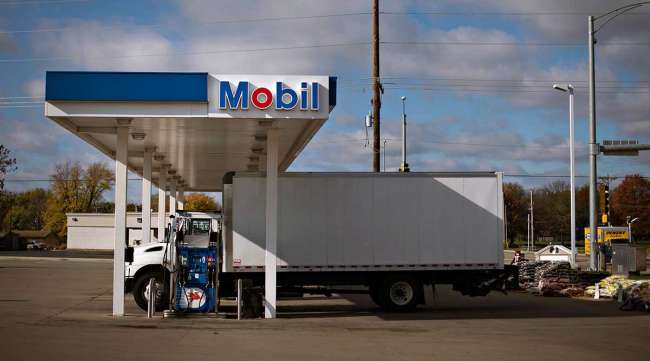Senior Reporter
Diesel Slips 0.5¢ After Six Straight Increases

[Stay on top of transportation news: Get TTNews in your inbox.]
After six consecutive weeks of increases, the national retail price of diesel fell by five-tenths of a cent to $2.433 a gallon from $2.438 the previous week, the Energy Information Administration reported July 20.
With the decrease, the price of trucking’s primary fuel is 61.1 cents a gallon less than it was a year ago.
Meanwhile, the national average price of a gallon of gasoline also declined, by nine-tenths of a cent to $2.186.
The price of diesel decreased in eight of the 10 regions of the country surveyed by EIA, increasing only on the West Coast, not including California, where prices moved up three-tenths of a cent. In that region, the price rose to $2.597 a gallon from $2.594 the previous week. Diesel still is 60.1 cents less expensive in that region than it was a year ago.
The price remained flat along the Gulf Coast at $2.198 a gallon, 60.6 cents less than it was the previous year. The Gulf Coast is home to much of the nation’s oil and gasoline production and a large share of the refining capacity. Generally, the lower cost of transporting crude oil and refined products keeps prices down substantially.
The most expensive diesel remains in California, where the average price declined three-tenths of a cent to $3.248 a gallon. Still, that is 69.1 cents cheaper than at this time in 2019.
The biggest decline was in New England, where diesel fell 2.4 cents per gallon from $2.650 to $2.626. In that region, diesel is 49.6 cents less expensive than a year ago.
The East Coast also saw the price of diesel drop, by 1.1 cents a gallon to $2.520 a gallon. There, diesel is 55.2 cents less expensive than at this point in 2019.
Oil industry analyst Tom Kloza, founder of the Oil Price Information Service, told Transport Topics the drop in diesel and gas prices was modest.
“Most of the drop in price has been on the West Coast because there’s been a lot of demand destruction,” Kloza said. “We’re still in a funk because of COVID.”
California has been the largest of the states where governors and mayors are beginning to limit economic activity to slow the spread of the novel coronavirus. Texas, Florida, Arizona and Georgia are among other states where the virus has significantly trended upward.
“We peaked on most gas prices and crude prices on June 22. It’s been very modest, but the wholesale price for gasoline has dropped by 10 or 15 cents, and most of the drop has been on the West Coast,” said Kloza, who noted the price of gas and diesel likely will remain where it is now for most of the year. “On July 21, I counted about 50,000 locations throughout the country where you can get gas for less than $2 a gallon.”

Transport Topics introduces its newest digital interview series, Newsmakers, aimed at helping leaders in trucking and freight transportation navigate turbulent times. Audience members will gain access to the industry's leading expert in their particular field and the thoughtful moderation of a Transport Topics journalist. Our second episode — "The Evolution of Electric Trucks" — featuring Nikola founder and executive chairman Trevor Milton, will air live on July 28 at noon EDT. Registration is free but advance signup is required. Sign up today.
The weekly Baker Hughes rig count shows domestic oil production continues to fall. On July 19, 253 rigs were operating in the U.S., a drop of 73.4% from 954 a year ago.
Baker Hughes ranks No. 73 on the Transport Topics Top 100 list of the largest private carriers in North America.
In Canada, the number of rigs operating increased by six to 32, compared with 118 a year ago.
Internationally, 781 rigs are operating, but 1,138 were in service in July 2019.
The price of West Texas Intermediate crude oil, the industry benchmark, climbed to $40.81 on July 20. That price has been stable since the beginning of the month, and it’s more than $2 a barrel higher than it was a month ago, when oil traded at $38.49. But even at more than $40 a barrel, it’s still well below the 52-week high of $65.65.
The early week rally on oil prices appeared to end when the American Petroleum Institute reported crude oil inventories set a record of 538.8 million barrels. API said that even with more people driving, demand still remains soft. The report also said total U.S. petroleum inventories — which include crude oil and refined products, and exclude oil in the Strategic Petroleum Reserve — remain at near their record levels.
Signs that demand for petroleum products is creeping up are beginning to show. API said U.S. oil demand of 17.6 million barrels per day, led by motor gasoline, rose by 1.4 million barrels per day in June, and it’s up 2.9 million barrels per day since April.
Still, Kloza is not predicting a quick return to pre-pandemic oil usage levels.
“We still have a glut of crude oil and refined products,” Kloza said, “and it’s going to take a long time to reduce this glut.”
Want more news? Listen to today's daily briefing:
Subscribe: Apple Podcasts | Spotify | Amazon Alexa | Google Assistant | More




